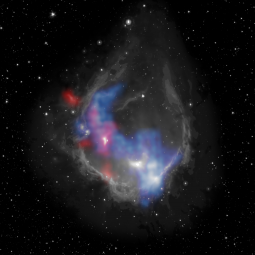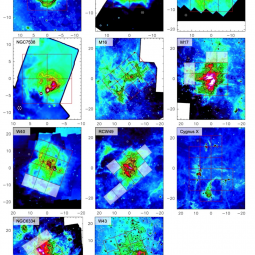by Nicola Schneider, Alexander Tielens, and Anashe Bandari
Paper:
FEEDBACK: a SOFIA Legacy Program to Study Stellar Feedback in Regions of Massive Star Formation
Schneider, N., et al., 2020/10, Publications of the Astronomical Society of the Pacific, 132j4301S.
The interaction of massive stars with their environments regulates the evolution of galaxies through a process called feedback. Mechanical input by massive stars stirs up the interstellar medium, greatly influencing the star formation efficiency of molecular clouds as, on the one hand, this disperses star forming molecular cloud cores and, on the other hand, it creates dense shells of swept up gas that are prone to gravitational collapse. In addition, the radiative energy input by massive stars creates ionized gas regions surrounded by dense photo-dissociation regions, and the spectral characteristics of these regions dominate the emission of galaxies. This gas heating also controls the cloud and intercloud phases of the interstellar medium and thereby the overall structure of the interstellar medium.
The high sensitivity, high spectral resolution, and fast mapping speed of the upGREAT heterodyne instrument on SOFIA provides a unique tool to study this feedback of massive stars on their surrounding medium. This instrument can probe the dominant cooling line of moderate density gas illuminated by strong far-UV radiation fields, allowing us to quantify the relationship between the energy injected by star formation activity and the feedback processes involved.
By mapping the [CII] 158 μm line in molecular clouds, the FEEDBACK Legacy Program has measured this energetic interaction in 11 regions of massive star formation. The sample spans a range in stellar characteristics from regions dominated by single O stars to clusters containing dozens of O and Wolf-Rayet stars, in evolutionary age from hundreds of thousands to several million years, and in star formation activity from isolated O star birth-sites to massive, star-forming, giant molecular cloud complexes and starburst environments. Figure 2 summarizes the targeted sources and the areas surveyed. The data contain fully sampled maps of [CII] 1.9 THz for each source at high spatial (14") and spectral (0.3 km/s) resolution. All data is available through the IRSA SOFIA Archive .
In a study of the Orion molecular cloud, FEEDBACK surveyed the bubbles blown by θ1 Orionis C, Nu Orionis, and 42 Orionis (e.g. associated with M42/the Veil Nebula, M43, and NGC 1977), revealing the large amounts of kinetic and thermal energy in the warm swept-up neutral shells.
Another region FEEDBACK studied was RCW 120, a nearby (~1.7 kpc) HII region with a physical diameter of ~4.5 pc. This region is ionized by a single O8V star, moving at about 4 km/s through the molecular cloud, with a fast stellar wind that has created a bow shock and swept up a dense, fragmented shell, the site of triggered star formation. FEEDBACK’s [CII] 1.9 THz observations reveal that this shell contains about 500 solar masses of neutral gas expanding at 15 km/s. The kinetic energy involved in the shell’s expansion represents a major fraction of the mechanical energy injected by the star over its 150,000-year lifetime through its stellar wind.
The FEEDBACK survey has revealed that efficient conversion of stellar wind mechanical energy into kinetic and turbulent motion of surrounding atomic and molecular gas is a common characteristic during the early stages of HII region evolution, but this conversion efficiency decreases with age as bubbles burst open and vent the over-pressurized hot gas into their environment.
Combined with ancillary data, FEEDBACK’s [CII] maps can be used to quantify the physical conditions in the dense, warm shells swept up in photodissociation regions.

